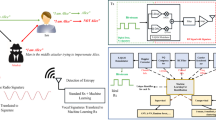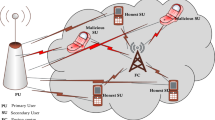Abstract
Today’s wireless communication systems are highly susceptible to malicious jamming attacks and interference signals. These attacks are sent via communication link at the same frequency as the intended signal. The sent information is thus corrupted and the receiver is unable to correctly decode the sent data stream. This paper thereby seeks to come up with an anti-jamming system that is able to respond intelligently to such malicious attacks, block them and enable the correct decoding of a message. The proposed system objectives are to ensure that data throughput is at its highest, energy consumption at the lowest level and the bit error rate is maintained at a very low level during and after any jamming attack. The system is also able to identify jammer state from transmit power and respond accordingly.
















Similar content being viewed by others
References
Kim, Y. (2015). Channel-hopping scheme for enhancing fairness performance under smart jammer attacks in tactical WLANs. The Journal of Korean Institute of Communications and Information Sciences, 40, 2188–2195.
Djuraev, S., Choi, J.-G., Sohn, K.-S., & Nam, S. Y. (2017). Channel hopping scheme to mitigate jamming attacks in wireless LANs. EURASIP Journal on Wireless Communications and Networking, 1, 11.
Grover, Kanika, Lim, Alvin, & Yang, Qing. (2014). Jamming and anti-jamming techniques in wireless networks: A survey. International Journal of Ad Hoc and Ubiquitous Computing, 17, 197–215.
Aravind Kuma, N., & Premchand, P. (2015). Secure anti jamming system for wireless sensor networks MAC protocols. International Journal of Conceptions on Computing and Information Technology, 3, 2345–9808.
Krattenthaler, W., & Hlawatsch, F. (1993). Time-frequency design and processing of signals via smoothed Wigner distributions. IEEE Transactions on Signal Processing, 41, 278.
Sun, Kewen, Jin, Tian, & Yang, Dongkai. (2015). An improved time-frequency analysis method in interference detection for GNSS receivers. Sensors, 15, 9404–9426.
Rezaei, M. J., Abedi, M., & Mosavi, M. R. (2016). New GPS anti-jamming system based on multiple short-time Fourier transform. IET Radar, Sonar and Navigation, 10, 807–815.
Musumeci, L., & Dovis, F. (2014). Use of the wavelet transform for interference detection and mitigation in global navigation satellite systems. International Journal of Navigation and Observation. http://dx.doi.org/10.1155/2014/262186
Mosavi, M. R., Pashaian, M., Rezaei, M. J., & Mohammadi, K. (2015). Jamming mitigation in global positioning system receivers using wavelet packet coefficients thresholding. IET Signal Processing, 9, 457–464.
Guo, J., Zhao, N., Yu, F. R., Li, M., Leung, & V. C. M. (2015). A novel anti-jamming scheme for interference alignment (IA)-based wireless networks. In IEEE/CIC international conference on communications in China (pp. 1–5).
Rawat, D. B., & Song, M. (2015). Securing space communication systems against reactive cognitive jammer. In IEEE wireless communications and networking conference (pp. 1428–1433).
Dai, Weihua, Qiao, Chunjie, Wang, Yueke, & Zhou, Chao. (2016). Improved anti-jamming scheme for direct-sequence spread-spectrum receivers. Electronics Letters, 52(161–163), 9.
Pashaian, M., Mosavi, M. R., Moghaddasi, M. S., & Rezaei, M. J. (2016). A novel interference rejection method for GPS receivers. Iranian Journal of Electrical and Electronic Engineering, 12(1), 9–20.
Hurley, P., & Simeoni, D. B. (2016). Flexibeam: Analytic spatial filtering by beamforming. In IEEE international conference on acoustics, speech and signal processing (pp. 2877–2880).
Rozic, N., & Radic, J. (2010). Theoretical analysis of iterative signal reconstruction for impulsive noise mitigation in OFDM systems. International Journal of Communication Systems, 23, 277–298.
Yue, G. (2008). Anti-jamming coding techniques: Link maintenance in cognitive radio systems. IEEE Signal Processing Magazine, 25, 35–45.
Zhang, H., & Li, Y. G. (2003). Anti-jamming property of clustered OFDM for dispersive channels. In Proceedings IEEE Conference on Military Communications (MILCOM’03) (Vol. 1, pp. 336–340).
Luo, J., Andrian, J. H., & Zhou, C. (2007). Bit error rate analysis of jamming for OFDM systems. In Wireless telecommunication symposium (WTS’07) (pp. 1–8).
Hanawal, M. K., Abdel-Rahman, M. J., & Krunz, M. (2015). Joint adaptation of frequency hopping and transmission rate for anti-jamming wireless systems. IEEE Transactions on Mobile Computing, 15, 2247–2259.
Li, J., & Haggman, S. G. (2006). Performance improvement of IEEE802.16-2004 system in jamming environment via link adaptation. In Proceedings of IEEE conference on military communications (MILCOM’06) (pp. 1–6).
Yong, S., & Xiaotao, F. (2011). A novel MLT-based ETF-OFDM system for anti-jamming communications. Chinese Journal of Electronics, 20(4), 719–724.
Lajnef, H., Dakhli, M. C., Hizem, M., & Bouallegue, R. (2016). The effect of the nonlinear distortion on OFDM based cognitive radio systems over rayleigh fading channel. In International conference on advanced information networking and applications workshops (pp. 427–430).
Chen, J.-D., & Ueng, F.-B. (2015). Adaptive antennas for MIMO OFDM-CDMA communication systems. Wireless Communications and Mobile Computing, 15, 484–499.
Patel, C. S., Stuber, G. L., & Pratt, T. G. (2004). Analysis of OFDM/MC-CDMA under imperfect channel estimation and jamming. IEEE Wireless Communication and Networking Conference (WCNC), 2, 954–958.
Lin, S.-C., & Ho, C.-Y. (2015). Performance analysis of MRT-MIMO for OFDM systems over fading channels with cochannel interference. In International conference on information, communications and signal processing (pp. 1–5).
Venkataraman, V., Cagley, R. E., & Shynk, J. J. (2003). Adaptive beamforming for interference rejection in an OFDM system. In 37th Asilomar conference on signals, systems and computers (Vol. 1, pp. 507–511).
Toutounchian, M. A., & Vaughan, R. G. (2015). Beamforming for multiuser MIMO-OFDM interference channels with multipath diversity. IEEE Transactions on Wireless Communications, 14, 1213–1225.
Somrobru, M., Sutthisangiam, N., & Pirak, C. (2016). Interference cancellation using joint beamforming and power control techniques in cooperative networks. In International conference on advanced communication technology (pp. 1–6).
Lohn, J. D., Becker, J. M., & Linden, D. S. (2011). An evolved anti-jam adaptive beamforming network. Genetic Programming and Evolvable Machines (Springer), 12, 217–234.
Chung, J., Yun, Y., & Choi, S. (2011). Prototype implementation of adaptive beamforming MIMO-OFDMA system based on IEEE 802.16e WMAN standard and its experimental results. International Journal of Communication Systems, 24, 1627–1646.
Hassan, E. S., et al. (2011). Performance evaluation of OFDM and single-carrier systems using frequency domain equalization and phase modulation. International Journal of Communication Systems, 24, 1–13.
Chi, D. W., Das, P. (2007). Effects of nonlinear amplifier and partial band jammer with application to 802.11n WLAN. In Proceedings of IEEE conference on military communications (MILCOM’07).
Ozdemir, M. K., & Arsalan, H. (2007). Channel estimation for wirelesss OFDM systems. IEEE Communication Surveys and Tutorials, 9(2), 18–48. (second quarter).
Mousa, A., & Mahmoud, H. (2011). Reducing ICI effect in OFDM system using low complexity Kalman filter based on comb-type pilots arrangement. International Journal of Communication Systems, 24, 53–61.
Alamouti, S. M. (1998). A simple transmit diversity technique for wireless communications. IEEE Journal on Selected Areas in Communications, 16(8), 1451–1458.
Air interface for fixed broadband wireless access systems, IEEE Standard 802.16d (2004).
Van Veen, B. D., & Buckley, K. M. (1988). Beamforming: a versatile approach to spatial filtering. IEEE ASSP Magazine, 5, 4–24.
Xiao, H., & de Lamare, R. C. (2012). Reduced rank space-time adaptive interference suppression for navigation systems based onQR decomposition and approximation of basis functions. International Journal of Communication Systems, 25, 616–635.
Hung, E. K., & Turner, R. M. (1983). A fast beamforming algorithm for large arrays. IEEE Transactions Aerospace and Electronic Systems, 19(4), 598–607.
Stoica, P., Wang, Z., & Li, J. (2003). Robust capon beamforming. IEEE Signal Processing Letters, 10(6), 172–175.
Cho, Y. S., Kim, J., Yang, W. Y., & Kang, C. G. (2010). MIMO-OFDM wireless communications with Matlab. Singapore: Wiley.
Kim, H. S., & Daneshard, B. (2010). Energy-constrained link adaptation for MIMO OFDM wireless communication systems. IEEE Transactions on Wireless Communications, 9(9), 2820–2832.
Kim, H.S., & Daneshard, B. (2008). Energy-aware link adaptation for MIMO-OFDM based wireless communication. In IEEE military communications conference (MilCom’08), Nov. 2008.
Javed, I. (2014). Cognitive signal processing techniques for secure OFDM-MIMO wireless communication system, Department of Electrical Engineering, UET, Lahore, National Library of Engineering Sciences, Pakistan, 621.3822 I 8 C.
Author information
Authors and Affiliations
Corresponding author
Rights and permissions
About this article
Cite this article
Sani, S.S., Yaqub, A. MIMO-OFDM Energy Efficient Cognitive System with Intelligent Anti-jam Capability. Wireless Pers Commun 98, 2291–2317 (2018). https://doi.org/10.1007/s11277-017-4975-8
Published:
Issue Date:
DOI: https://doi.org/10.1007/s11277-017-4975-8




